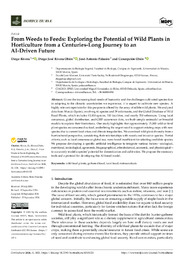Título :
From Weeds to Feeds: Exploring the Potential ofWild Plants in Horticulture from a Centuries-Long Journey to an AI-Driven Future |
Autor :
Rivera, Diego
Rivera Obón, Diego José
Palazón, José Antonio
Obón, Concepción |
Editor :
MDPI |
Departamento:
Departamentos de la UMH::Biología Aplicada |
Fecha de publicación:
2024 |
URI :
https://hdl.handle.net/11000/38293 |
Resumen :
Given the increasing food needs of humanity and the challenges cultivated species face
in adapting to the climatic uncertainties we experience, it is urgent to cultivate new species. A
highly relevant repertoire for this purpose is offered by the array of edible wild plants. We analyzed
data from Murcia (Spain), involving 61 species and 59 informants, and the Global Database ofWild
Food Plants, which includes 15,000 species, 500 localities, and nearly 700 references. Using local
consensus, global distribution, and GBIF occurrence data, we built simple unimodal or bimodal
models to explore their limitations. Our study highlights that approximately 15,000 wild or feral
plant species are consumed as food, underlining the urgent need to support existing crops with new
species due to current food crises and climate irregularities. We examined wild plant diversity from a
horticultural perspective, considering their relationships with weeds and invasive species. Partial
criteria, such as local consensus or global use, were found insufficient for selecting candidate species.
We propose developing a specific artificial intelligence to integrate various factors—ecological,
nutritional, toxicological, agronomic, biogeographical, ethnobotanical, economic, and physiological—
to accurately model a species’ potential for domestication and cultivation. We propose the necessary
tools and a protocol for developing this AI-based model.
|
Palabras clave/Materias:
wild food plants
gathered food
local food
nutraceuticals |
Tipo de documento :
info:eu-repo/semantics/article |
Derechos de acceso:
info:eu-repo/semantics/openAccess
Attribution-NonCommercial-NoDerivatives 4.0 Internacional |
DOI :
https://doi.org/10.3390/horticulturae10101021 |
Publicado en:
Horticulturae 2024, 10, 1021. |
Aparece en las colecciones:
Artículos - Biología Aplicada
|
 La licencia se describe como: Atribución-NonComercial-NoDerivada 4.0 Internacional.
La licencia se describe como: Atribución-NonComercial-NoDerivada 4.0 Internacional.
.png)
